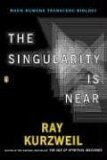Summary | Excerpt | Reviews | Beyond the Book | Readalikes | Genres & Themes | Author Bio

Critics' Opinion:
Readers' Opinion:
First Published:
Sep 2005, 672 pages
Paperback:
Sep 2006, 672 pages
I still recall the time in 1968 when I was allowed into the
secure, cavernous chamber housing what was then the most powerful computer in
New England, a top-of-the-line IBM 360 Model 91, with a remarkable million bytes
(one megabyte) of 'core' memory, an impressive speed of one million instructions
per second (one MIPS), and a rental cost of only one thousand dollars per hour.
I had developed a computer program that matched high-school students to
colleges, and I watched in fascination as the front-panel lights danced through
a distinctive pattern as the machine processed each student's application. Even
though I was quite familiar with every line of code, it nonetheless seemed as if the computer were deep in thought when the lights dimmed for
several seconds at the denouement of each such cycle. Indeed, it could do
flawlessly in ten seconds what took us ten hours to do manually with far less
accuracy.
As an inventor in the 1970s, I came to realize that my
inventions needed to make sense in terms of the enabling technologies and market
forces that would exist when the inventions were introduced, as that world would
be a very
different one from the one in which they were conceived. I began to develop
models of how distinct technologies—electronics, communications, computer
processors, memory, magnetic storage, and others—developed and how these changes
rippled through markets and ultimately our social institutions. I realized that
most inventions fail not because the R&D department can't get them to work but
because the timing is wrong. Inventing is a lot like surfing: you have to
anticipate and catch the wave at just the right moment.
My interest in technology trends and their implications took
on a life of its own in the 1980s, and I began to use my models to project and
anticipate future technologies, innovations that would appear in 2000, 2010,
2020, and beyond. This enabled me to invent with the capabilities of the future
by conceiving and designing inventions using these future capabilities. In the
mid-to-late 1980s, I wrote my first book,
The Age of Intelligent Machines.
It included extensive (and reasonably accurate) predictions for the 1990s and
2000s, and ended with the specter of machine intelligence becoming
indistinguishable from that of its human progenitors within the first half of
the twenty-first century. It seemed like a poignant conclusion, and in any event
I personally found it difficult to look beyond so transforming an outcome.
Over the last twenty years, I have come to appreciate an
important meta-idea: that the power of ideas to transform the world is itself
accelerating. Although people readily agree with this observation when it is
simply stated, relatively few observers truly appreciate its profound
implications. Within the next several decades, we will have the opportunity to
apply ideas to conquer age-old problems—and introduce a few new problems along
the way.
During the 1990s, I gathered empirical data on the apparent
acceleration of all information-related technologies and sought to refine the
mathematical models underlying these observations. I developed a theory I call
the law of accelerating returns, which explains why technology and evolutionary
processes in general progress in an exponential fashion. In The Age of Spiritual Machines (ASM),
which I wrote in 1998, I sought to articulate the nature of human life as it
would exist past the point when machine and human cognition blurred. Indeed,
I've seen this epoch as an increasingly intimate collaboration between our
biological heritage and a future that transcends biology.
Since the publication of
ASM,
I have begun to reflect on the future of our civilization and its relationship
to our place in the universe. Although it may seem difficult to envision the
capabilities of a future civilization whose intelligence vastly outstrips our
own, our ability to create models of reality in our mind enables us to
articulate meaningful insights into the implications of
this impending merger of our biological thinking with the nonbiological
intelligence we are creating. This, then, is the story I wish to tell in this
book. The story is predicated on the idea that we have the ability to understand
our own intelligence—to access our own source code, if you will—and then revise
and expand it.
From The Singularity is Near by Ray Kurzweil. Copyright Ray Kurzweil 2005. All rights reserved. Reproduced by permission of the publisher.





The House on Biscayne Bay
by Chanel Cleeton
As death stalks a gothic mansion in Miami, the lives of two women intertwine as the past and present collide.

The Flower Sisters
by Michelle Collins Anderson
From the new Fannie Flagg of the Ozarks, a richly-woven story of family, forgiveness, and reinvention.

The Funeral Cryer by Wenyan Lu
Debut novelist Wenyan Lu brings us this witty yet profound story about one woman's midlife reawakening in contemporary rural China.
Your guide toexceptional books
BookBrowse seeks out and recommends the best in contemporary fiction and nonfiction—books that not only engage and entertain but also deepen our understanding of ourselves and the world around us.